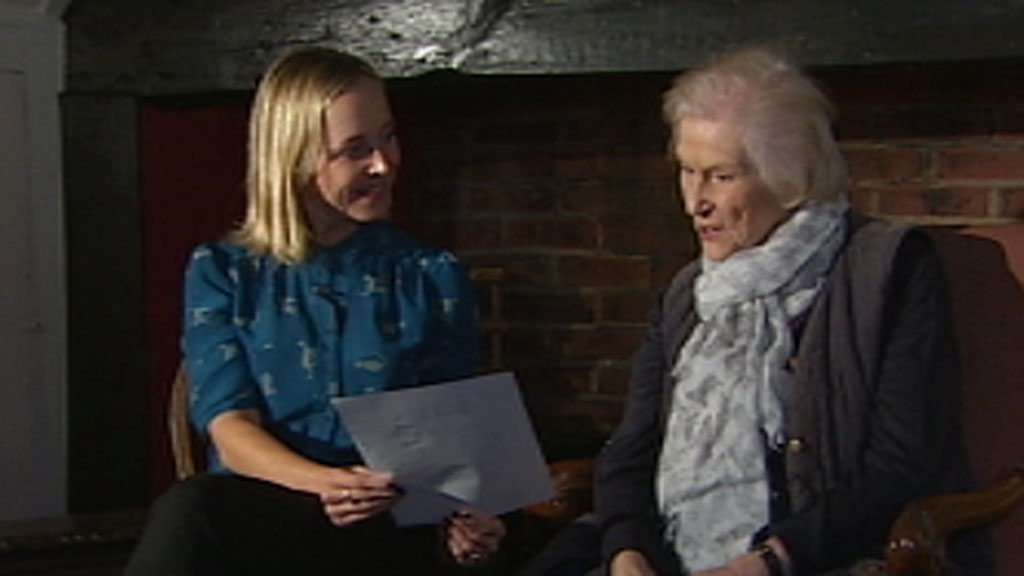Aero Girls mystery: painter and sitter reunited
Channel 4 News reveals another jigsaw piece in the mystery of the Aero Girls – the women who advertised chocolate in the 1950s but until now, were unknown.
Call me a nostalgia freak, but the opportunity to revisit the Aero Girls was too good to pass up.
Remember the story? A series of portraits done in the 1950s of mystery women, used to advertise Aero chocolate. Clearly they were not mystery women back in the day. The advertisers, the artists, even some of the consumers of the chocolate must have known who the Aero Girls were. But the records have disappeared, as had the paintings, until archivists at York University’s Borthwick Institute came upon some of them tucked away in the boxes of paperwork labelled “Rowntree”.
I needed a few bob… the student grant was £3 a week, not much to live on. Frederick Deane, artist
They are a stunning reminder of a bygone era; the majority painted in oil, these women gaze out, frozen in time. This was the heyday of chocolate-making in York and Britain was emerging into a new post-war atmosphere. Why Rowntree’s chose expensive oils and a multitude of women for a costly campaign is not entirely clear, and is an insight into what our country felt like at the time.
With the help of Kerstin Doble and Francesca Taylor at the Borthwick Institute we’ve already tracked down one of the Aero Girls, 93-year old Pamela Synge.

(Image montage: Nestlé/Kerstin Doble)
Now, with a little more detective work, we have found the man we believe is the last surviving artist involved in the campaign and one of the women he painted.
Frederick Deane is a wonder; almost 90, sporting the eye patch he has needed ever since his eye was shot out at the Battle of Arnhem in the second world war, he welcomed us into his Snowdonia home to relive his role in the Aero Girls campaign. He is a lover of life, with a hearty laugh and a terrific memory. He recounted in detail the meetings he had at the offices of Rowntree’s advertising firm J Walter Thompson in London’s Berkeley Square.
Deane was a student at the Royal Academy after the war. He was spotted and commissioned to paint for JWT on £300 a year, as long as he didn’t work commercially for anyone else. It was a fortune to the young artist, he told me: “I needed a few bob… the student grant was £3 a week, not much to live on.” With the first installment of £40, he bought a smart overcoat.
JWT asked Frederick Deane to paint women for the Aero Girls campaign. The tagline was “the milk chocolate that’s different”, though he laughed when he told me he didn’t pay any attention to that. He just painted.

Vogue model
One of the women was a renowned model at the time, Myrtle Crawford. So famous she made the front cover of Vogue numerous times, her wedding was in the paper and she presumably offered ready glamour to the advertising campaign.
Mr Deane remembers a lot about their first encounter. She was beautiful, of course, and he had not yet been paid, so when the JWT boss told him to take her in a taxi to the Academy and get started, he had to admit he “hadn’t tuppence to rub together”. JWT had to stump up the cash.
Unlike many of the other Aero Girl portraits, the picture Mr Deane did of Myrtle Crawford in just two sittings has disappeared. All that remains is his photograph of it on the back of which he had written her name. It was enough for us to find the now 85-year old, living in Devon, and painting a bit herself.
The most wonderful part was getting them to Skype each other, 60-odd years after their brief encounter. There were smiles all round and a memory from Myrtle, now Acland, that “we had some lovely conversations.”
She admitted to me she has never liked chocolate much (bad luck Aero), but both agreed it was a treat to take a trip down memory lane after all these years. The next task is to find the actual portrait…
Anyone with any information about the Aero Girls should contact: whoweretheaerogirls@gmail.com
(Aero Girls images courtesy of Nestlé)
